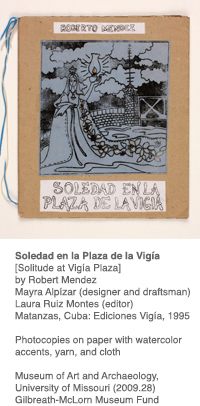
Ediciones Vigía: An Introduction

All of the books featured on this site are products of Ediciones Vigía, an independent publishing house located in Matanzas, Cuba. Handmade using collaged, repurposed materials, these books were created by artisans who volunteer at the press. Rolando Estévez Jordán, chief designer and draftsman of Vigía, and Alfredo Zaldívar, a Cuban poet, co-founded Ediciones Vigía in April of 1985.1 Vigía originally opened as a space for writers and artists to gather and discuss their work. The group began creating single-sheet flyers that advertised meeting times for interested artists, and eventually they evolved into a book publishing house.2 Estévez, Zaldívar, and Zaldivíar’s successor, Agustína Ponce Valdéz, along with their colleagues comprised of writers, artists, and volunteers, have been working collaboratively since 1985 to publish handmade books that combine art, literature, and movable parts as exemplified in the books featured on this site.3 Today, the artists and volunteers at Vigía are recognized internationally for their ability to creatively repurpose materials and craft unique, interactive works of book art that feature the work of both Cuban and non-Cuban writers and poets.
Ediciones Vigía can be translated as Watchtower Editions and is named because of its location on the Plaza de la Vigía, or Watchtower Square, in an old colonial house in Estévez’s hometown of Matanzas, just east of Havana.4 Matanzas is city rich in culture. According to Stuart Ashman, Director of the Museum of Latin American Art in Long Beach, California, “Matanzas, the birthplace of the Rumba, has been known as a center of creativity so it is not surprising that this [artistic] spirit arises there.”5
Unlike other publishing houses that digitally print hundreds of copies of books on fresh clean paper, Vigía uses repurposed materials such as paper from the local butcher, yarn, fabric, leaves, dried flowers, tin foil, and various other materials to build a limited number of volumes—a maximum of 200 issues of each book published. Each issue is made by hand in the Matanzas workshop which results in individual objects that feature the same text, form, and general imagery, but sometimes differ in artistic details.6 In an interview published in the Michigan Quarterly Review in 1994, Estévez insisted that this hand crafted “editorial aesthetic was not chosen in 1985 out of material need or because there existed no other possibilities…. Vigía emerges out of aesthetic necessities.”7 Vigía’s goal is not just to publish books, but to publish beautiful books.
In designing the books, Estévez carefully considers how the materials and the production process affect the final aesthetic of the objects. In the 1994 interview, Zaldívar explains,
Ediciones Vigía emerged out of the need of a group of artists of the city to see their work, which they valued as literature, in print. We did not have a preconceived idea about what the volumes would look like. Our resources were scarce: a mimeograph machine that someone from a press was able to lend us, and a typewriter—also borrowed—because we owned neither. These are the only two machines we have used in the history of Vigía. More than anything, we use our hands and our imagination.8
The combination of photocopied images with handwritten text and collaged materials is characteristic of Vigía and reflects not only the technological limitations of the small press but also the conditions in which the books are made. Using repurposed materials and little machinery, the books and their handcrafted qualities reflect the everyday economic hardships of Cubans.
In its early years, Vigía published books and poems written by relatively unknown Cuban authors in order to increase awareness and audience of national writers. While the production process has changed little since the 1980s, the press has expanded its collection of published authors, which now includes stories, histories, and poems by well-known writers like Gabriel García Marquez, Hans Christian Andersen, Emily Dickinson, and celebrated Cuban poet Nancy Morejón.9 Members of the Vigía collective carefully select the authors who are published based on their own personal appreciation for the writers.10
Perhaps the most important idea to keep in mind when viewing these books is the fact that Estévez is an artist who relies heavily on the use of symbols. All of the components of the books—the materials, the design, the text, the images—connect to each other and the author’s writing in some way. Viewers can interpret these layered and complex books in equally layered and complex ways, which appears to be exactly what Estévez intends for these publications. As Maria Rodriguez-Alcalá expresses, Estévez seems to encourage readers and viewers to find their own meaning in his designs and seems pleased when they do. Estévez sees in Vigía books the freedom of interpretation.11
- 1 María Eugenia Alegría, Rolando Estévez, and Alfredo Zaldívar, “Vigía: The Endless Publications of Matanzas,” in Michigan Quarterly Review, ed. Ruth Behar and Juan Leon. Vol. 33 No. 4 (Fall 1994), 829.
- 2 Discussion with Maria Rodriguez-Alcalá, March 15, 2012.
- 3 Peggy Sue Dunigan, “Latino Arts Inc. Shines Light on ‘Cuban Artists’ Books and Prints,” ExpressMilwaukee.com, December 8, 2009, accessed October 4, 2010, http://www.expressmilwaukee.com/article-9118-latino-arts-inc-shines-light-on-lscuban-artistsrs-books-and-printsrs.html.
- 4 “Ediciones Vigía,” British Library, accessed September 28, 2010, http://www.bl.uk/reshelp/findhelplang/spanish/hispcoll/hispexhibl/edicionesvigoia/edex.html.
- 5 Personal interview with Stuart Ashman, January 13, 2012.
- 6 Richard Goodman, “Postcards from Havana: A Show of Cuban Artist Books is No Message in a Bottle.” Fine Books & Collections, July 2009. Accessed September 28, 2010. http://www.finebooksmagazine.com/issue/200907/cuban-1.phtml.
- 7 María Eugenia Alegría, “Vigía: The Endless Publication of Mantanzas,” 831.
- 8 María Eugenia Alegría, “Vigía: The Endless Publication of Mantanzas,” 830.
- 9 Jennifer Ehrenberg, “¡Cuba Libros!” Print, February 2008, 89.
- 10 Discussion with Maria Rodriguez-Alcalá, faculty member at the University of Missouri and visitor to the press in Matanzas, March 15, 2012.
- 11 Discussion with Rodriguez-Alcalá, March 15, 2012.
